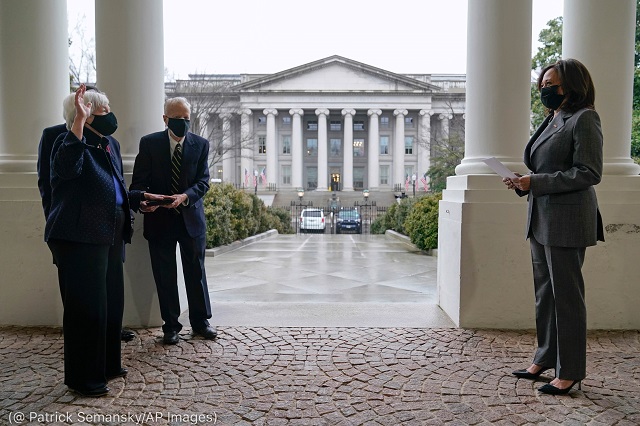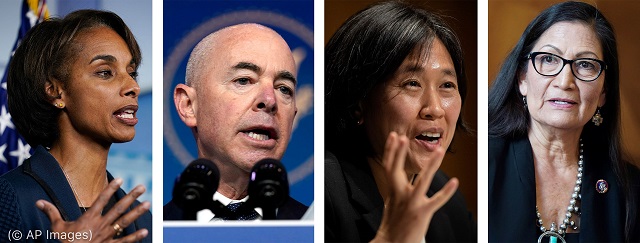Promoting diversity and inclusion with a government that looks like America is a priority for the Biden-Harris administration — and new data from the White House shows it’s the most diverse government in America’s history.
In their first 100 days in office, President Biden and Vice President Harris assembled a group of nearly 1,500 diverse and highly qualified individuals to serve in the Cabinet and other positions in the executive branch. These public servants represent minority groups across America that have been previously underrepresented at the highest levels of government.
The most senior officials require Senate confirmation by majority vote in order to serve in the president’s Cabinet.

Vice President Harris participates in a swearing-in ceremony for Treasury Secretary Janet Yellen in Washington on January 26. (© Patrick Semansky/AP Images)
- Lloyd Austin is the first Black secretary of defense.
- Janet Yellen is the first woman to be secretary of the treasury.
- Alejandro Mayorkas is the first Latino and immigrant to serve as secretary of homeland security.
- Xavier Becerra is the first Latino to serve as secretary of health and human services.
- Deb Haaland, the secretary of the interior, is the first Native American to ever serve as a Cabinet secretary.
- Pete Buttigieg is the first openly LGBTQ+ person to serve as secretary of transportation.
- Cecilia Rouse is the first woman of color to chair the Council of Economic Advisers.
- Katherine Tai is the first woman of color to serve as U.S. trade representative.
- Avril Haines is the first woman to lead the U.S. intelligence community.
- Rachel Levine, serving in the Department of Health and Human Services, is the first openly transgender person to be confirmed by the Senate.

From left: Chair of the Council of Economic Advisers Cecilia Rouse, Homeland Security Secretary Alejandro Mayorkas, U.S. Trade Representative Katherine Tai and Interior Secretary Deb Haaland. (@ AP Images)
Beyond the Cabinet, presidential appointees serve in key agency positions that do not require Senate confirmation. In line with Biden’s commitment to leveraging the talent, creativity and expertise of the American people and to build an administration that looks like America, more than half of the 1,500 presidential appointees hired to date are women, and half identify as non-white. In this group of appointees:
- 58% are women.
- 18% identify as Black or African American.
- 15% identify as Latino or Hispanic.
- 15% identify as Asian American or Pacific Islander.
- 3% identify as Middle Eastern or North African.
- 2% identify as American Indian or Alaska Native.
- 14% identify as LGBTQ+.
- 4% are veterans.
- 3% identify as disabled or having a disability.
- 15% were the first in their families to go to college.
- 32% are naturalized citizens or the children of immigrants.
Across the federal government, Biden has committed to hiring qualified appointees from among historically underrepresented American communities.
At the State Department, Secretary Antony Blinken has emphasized that “diversity and inclusion make our diplomatic team stronger, smarter, more creative, more innovative.”
Speaking to the press after announcing former Ambassador Gina Abercrombie-Winstanley as the department’s first chief diversity and inclusion officer, Blinken added: “As President Biden has made clear, prioritizing diversity, equity, inclusion, and accessibility is also a national security imperative.”
Banner image: President Biden listens as Defense Secretary Lloyd Austin speaks at the Pentagon on February 10. (© Patrick Semansky/AP Images)







COMMENTS0
LEAVE A COMMENT
TOP